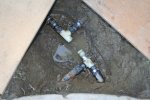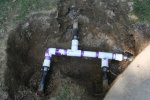Rob, you asked for it, so sit back with a cold drink and watch me make ~ 20 typos :lol: :
Let me start by saying that I am no fan of black poly! I think that a better/ more permanent seal is created with the chemical/ mechanical bond that PVC glue provides. However, sometimes you have no choice but to deal with the black poly. Black poly (bp from now on) is somewhat flexible so 45 deg fittings aren't often used, but 90 deg fittings are required to turn a corner, the flexablity can really help when in tight spots like you are.
OK, let's talk about making a bp connection - as you know, the fittings are barbed, this helps keep the fitting from pulling out and makes a watertight seal. However, to insure the seal, you need to clamp the pipe to the fitting. To facilitate the installation of the barbed fitting, you need to heat up the inside of the pipe, your propane torch is what I've always used (sorry if I used yours without permission

) - the idea is to heat up the inside of the pipe enough so that it will 'mold' to the barbs. Evenly heat the inside of the pipe until the pipe will readily compress when squoze between thumb and forefinger about 1/4". then insert the barb. -- You need to put 2(!!) clamps on the pipe first (i'll talk about the clamps in a minute) -- If the pipe is soft enough, the barb will just slide in, otherwise you may have to apply a bit of pressure to get it fully into the pipe. You do not want to heat the pipe so much that it becomes formless slag

Clamps! - they keep the barb in the pipe and fully seal them. You want good quality clamps (wish I could tell you more, but the heavier the gauge of the steel and better quality of the 'screw mechanism' the longer they'll last) and you want to use 2 per connection. When you use the 2, have them ready (opened enough to easily slide onto the pipe) when you heat the pipe and install them before 'jamming' the barb in. The clamps should have the tightening nuts facing you on either side of the pipe (I wish I could post pictures at this point because that doesn't explain it -- if you have the 2 clamps facing you, held next to each other, both the nuts are in the same placement in your hand [ie, the nuts are next to each other and facing you - turn 1 of them 180 deg so that it still has the nut facing you, but on the opposite side of the pipe] {I hope you understand what I'm struggling to say}) When you tighten the nuts, tighten them enough to be hard to turn more, but don't force them, and then wait till the pipe cools down and give them another turn. (using the right sized 'nutdriver' really helps for this!)
Phwew! that was just the bp part, and I've barely gotten started
 I
I would use flex pvc to make the repair. Similar in flexibility to the bp , but is glued into the pvc connections. To go this route, you will need to dig a little more, but you were suspecting that you'd need to anyway, and would also have to with the bp. If you go with pvc, you don't need to remove the old bp fittings, just cut the pipe 2" back from the existing fittings, though 4-5" would give you a little more 'room to move'. There is barbed fitting available that is sch 40 pvc and will accept a 1.5" pvc pipe, I think I can get the number if you need it, but that store talked about should have them. I would put 1 of these into every piece of bp, and use the glued flex pipe to make subsequent connections. Two 1.5" tees would complete the deal. Using the directions on the cans of pvc glue and primer, it's just a matter of making the final connection - the final connection should be the one with the longest run so that you have enough 'flex' in the pipe to do it.
I have not explained this as well as I would have liked - if someone else can help clarify, that'd be great! If you need some clarification from me, just ask
TRYING (probably unsuccessfully) to help




